Salads are a staple in many diets, but for those adhering to a ketogenic lifestyle, crafting a salad that’s both nutritious and low in carbohydrates is essential. Keto salads emphasize healthy fats, moderate protein, and low-carb vegetables.
They move away from traditional croutons and sugary dressings, favoring rich avocados, cheeses, nuts, and a variety of proteins like chicken, tuna, or eggs. They are a perfect dish to maintain ketosis, the metabolic state key to the ketogenic diet.
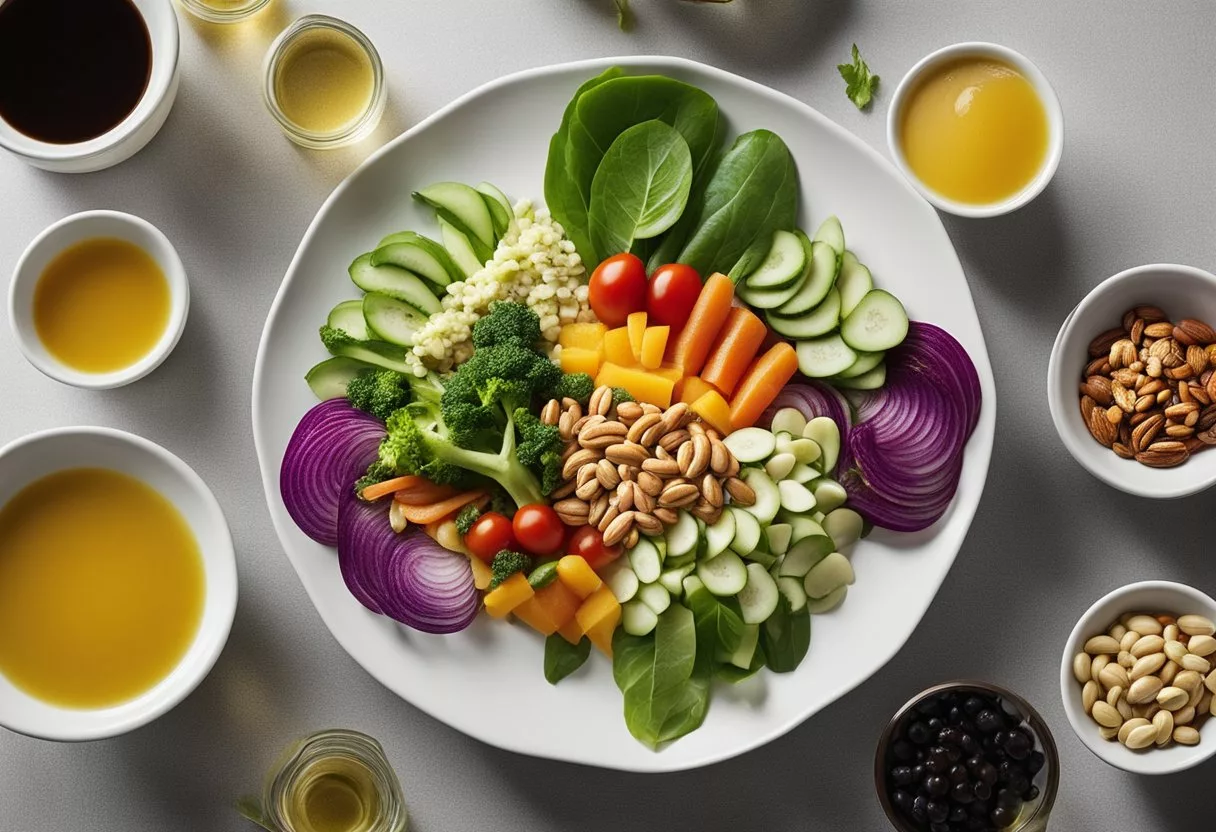
Creativity in assembling keto-friendly salads ensures that they are far from mundane. Swapping out high-carb greens for options like spinach, kale, or arugula increases the nutritional value and keeps the carb count in check.
Dressings made with olive oil or avocado oil, mixed with vinegar or citrus juice, complement the salad without adding unwanted carbs. These salads can be customized for any meal, whether it’s a hearty main or a light side dish.
Key Takeaways
- Keto salads focus on high-nutrition, low-carb ingredients suited for maintaining ketosis.
- A variety of proteins and healthy fats can be used to enrich these salads, promoting heart health.
- Preparing keto salads with fresh, seasonal produce enhances both nutrition and taste.
The Basics of a Keto Salad
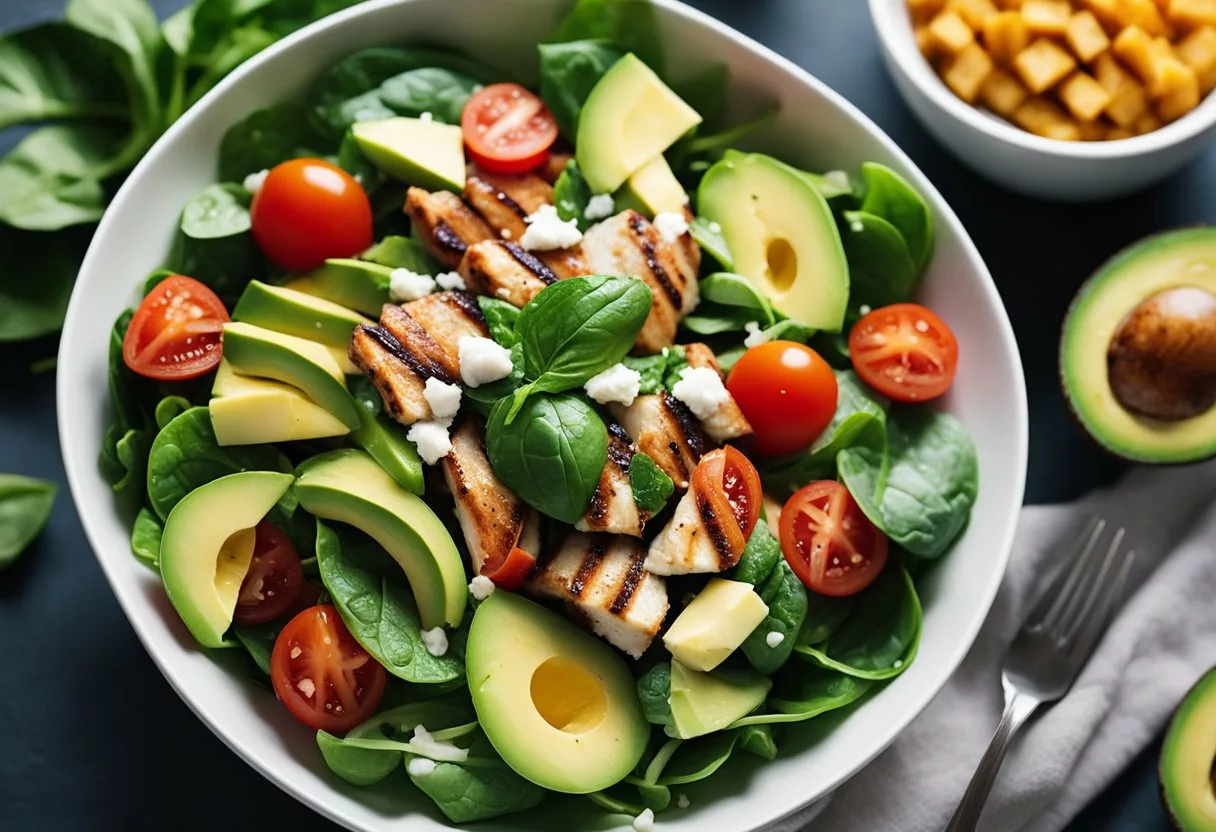
When creating a keto salad, an individual aims for a low carb, high-fat dish with a good amount of protein. The ingredients are chosen with care to ensure they adhere to the keto diet parameters while also providing essential nutrients and vitamins.
Choosing the Right Ingredients
A keto salad foundation relies on low-carb vegetables such as leafy greens. One should prioritize ingredients that are high in fiber and nutrients, but low in carbohydrates. Common options include:
- Romaine lettuce
- Spinach
- Kale
For added texture and flavor, incorporating a variety of seeds like sunflower or pumpkin seeds and nuts like almonds or pecans is suggested. These additions not only offer crunch but also deliver healthy fats that are essential to the keto diet.
Balancing Macronutrients
The key to a successful keto salad is ensuring the right balance of fats, proteins, and carbohydrates. Each element serves a purpose:
- Proteins can come from chicken, beef, or shrimp, providing the body with essential amino acids.
- Fats should come from high-quality sources like avocado, olive oil, or cheese.
- Carbohydrates are minimal but come in the form of fibrous vegetables and certain keto-friendly dressings.
By carefully selecting ingredients and understanding the role of macronutrients, one can craft a keto salad that is both satisfying and compliant with a ketogenic lifestyle.
Popular Keto Salad Greens
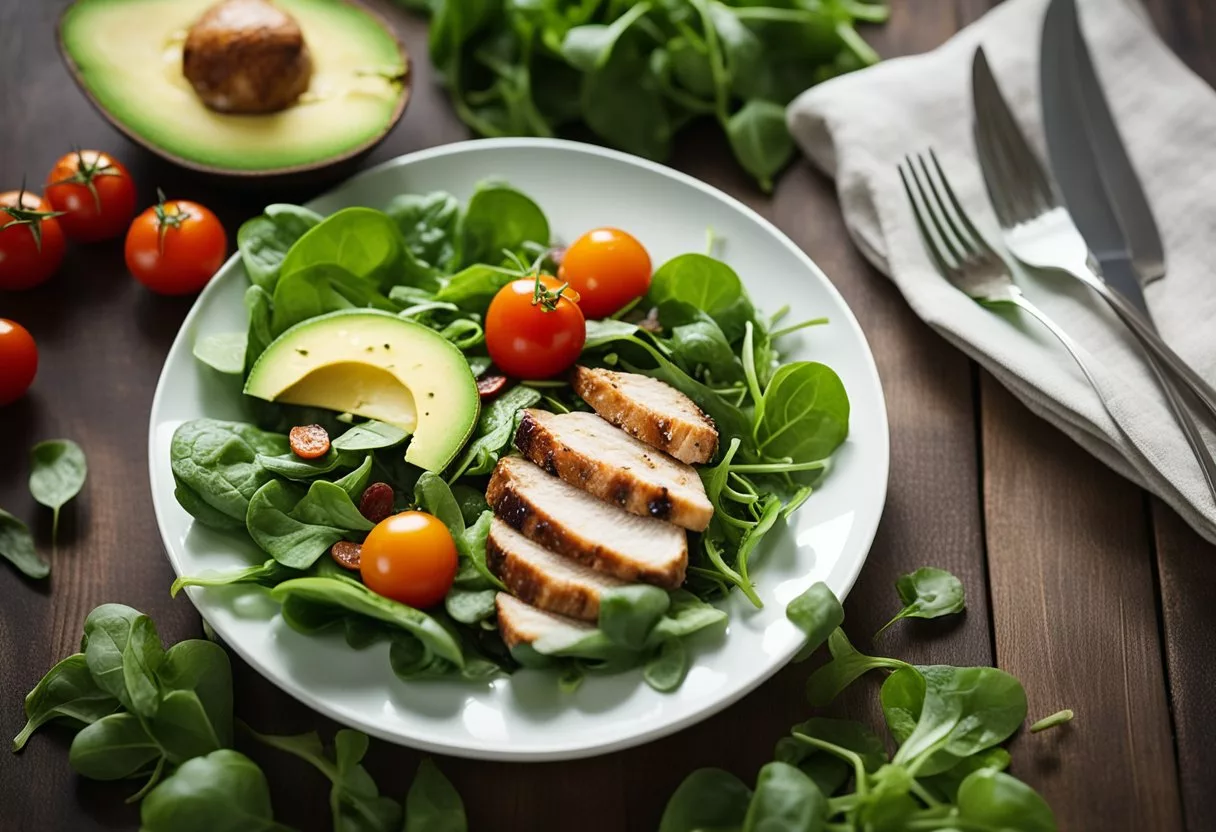
When constructing a flavorful keto salad, the greens you choose lay the foundation for a nutritious and satisfying meal. Opting for low-carb vegetables that are high in fiber and rich in essential vitamins and minerals will ensure both taste and health benefits.
Types of Lettuce
- Romaine Lettuce: A popular choice for keto dieters, romaine lettuce is crunchy and nutrient-dense. It holds up well under a variety of dressings.
- Iceberg Lettuce: Offers a satisfying crunch and is composed primarily of water, making it a hydrating, low-calorie option.
- Butterhead Lettuce (Boston or Bibb): Known for its tender and slightly sweet leaves, this lettuce variety adds a smooth texture to salads.
Spinach and Kale Options
- Spinach: A staple for keto salads, spinach is low in carbs and high in vitamins A, C, and K, as well as minerals like magnesium.
- Kale: It’s a bit higher in carbs but rich in nutrients, so it should be used in moderation. Kale’s sturdy texture pairs well with creamy dressings.
Using Herbs for Flavor
- Basil: With its sweet and peppery essence, basil can provide an aromatic twist to a simple keto salad.
- Cilantro: It lends a fresh, citrusy note to salads, excellent for pairing with a zesty lime dressing.
- Mint: Often overlooked in salads, mint can introduce a refreshing profile to heavier salad components.
Protein-Packed Keto Salads
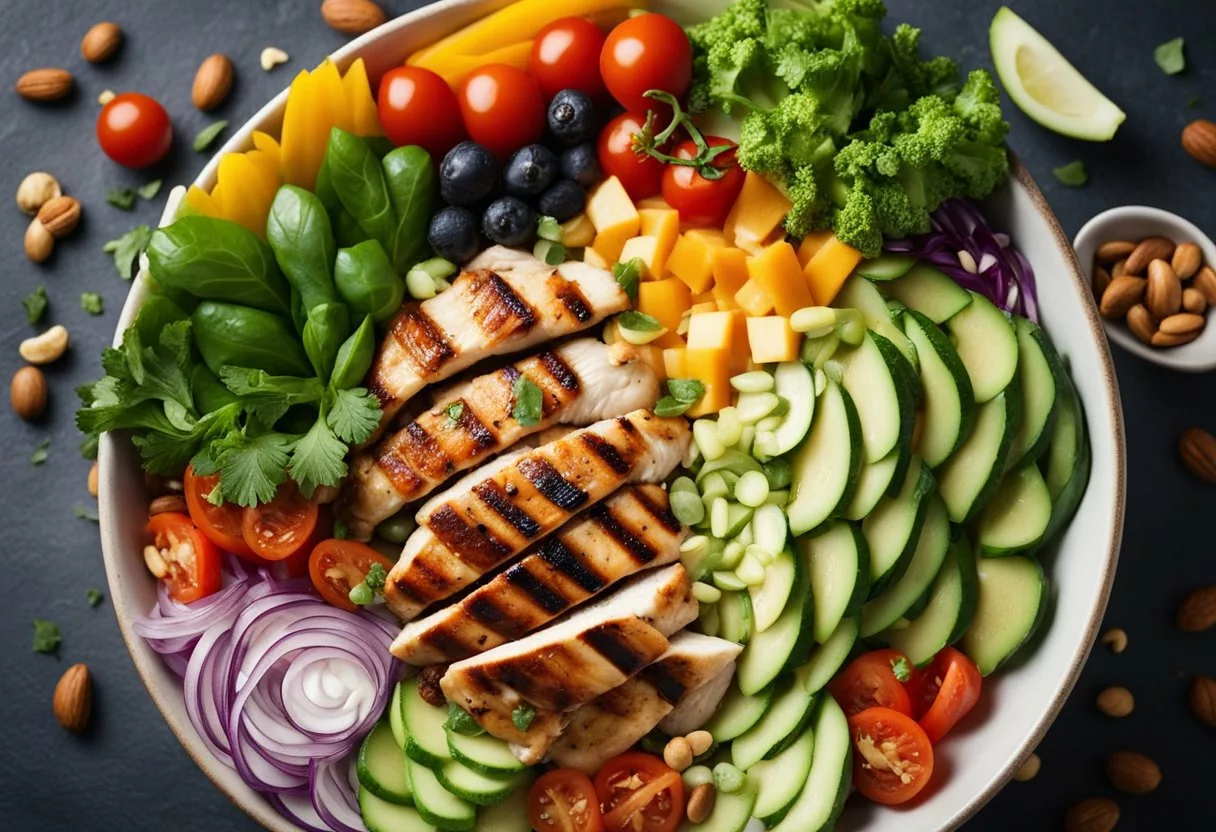
Protein is a crucial component of the keto diet, and incorporating it into salads can make for a satisfying and nutritious meal. Below, you’ll find carefully selected salad ideas rich in proteins from various sources such as chicken, beef, fish, seafood, and dairy.
Chicken and Beef Selection
Chicken Caesar Salad: A classic choice, it features grilled chicken, crisp romaine lettuce, and a generous sprinkling of parmesan cheese, elevating the protein content. For an added punch, crisp bacon bits can be included.
Cheeseburger Salad: This inventive salad captures the essence of a cheeseburger. Ground beef, sharp cheddar cheese, and fresh greens come together to create a fulfilling dish.
Steak Cobb Salad: A delectable mix of seared steak, hard-boiled eggs, and avocado combines with leafy greens. Feta or blue cheese crumbles finish the dish for a balance of flavors and an extra protein boost.
Fish and Seafood Varieties
Salmon Salad: A hearty option where flaked, cooked salmon serves as the main protein. It can be dressed with a lemony vinaigrette and paired with avocado for healthy fats.
Shrimp Salad: A quick and elegant choice that offers succulent shrimp over a bed of greens. Add a tangy dressing and fresh herbs to enhance the taste.
Including Eggs and Cheese
Egg Salad: Hard-boiled eggs, finely chopped and mixed with a keto-friendly mayonnaise, become a versatile protein-rich topping. Serve over a bed of spinach or kale for added nutrients.
Salami and Cheddar Salad: Cubes of cheddar cheese and slices of salami deliver a robust flavor and a good protein hit. Combine with mixed greens for a satisfying meal.
Each of these salads can be adjusted with preferred dressings and additional protein choices such as bacon or salami to fit individual tastes while staying within the keto guidelines.
Keto-Friendly Salad Dressings
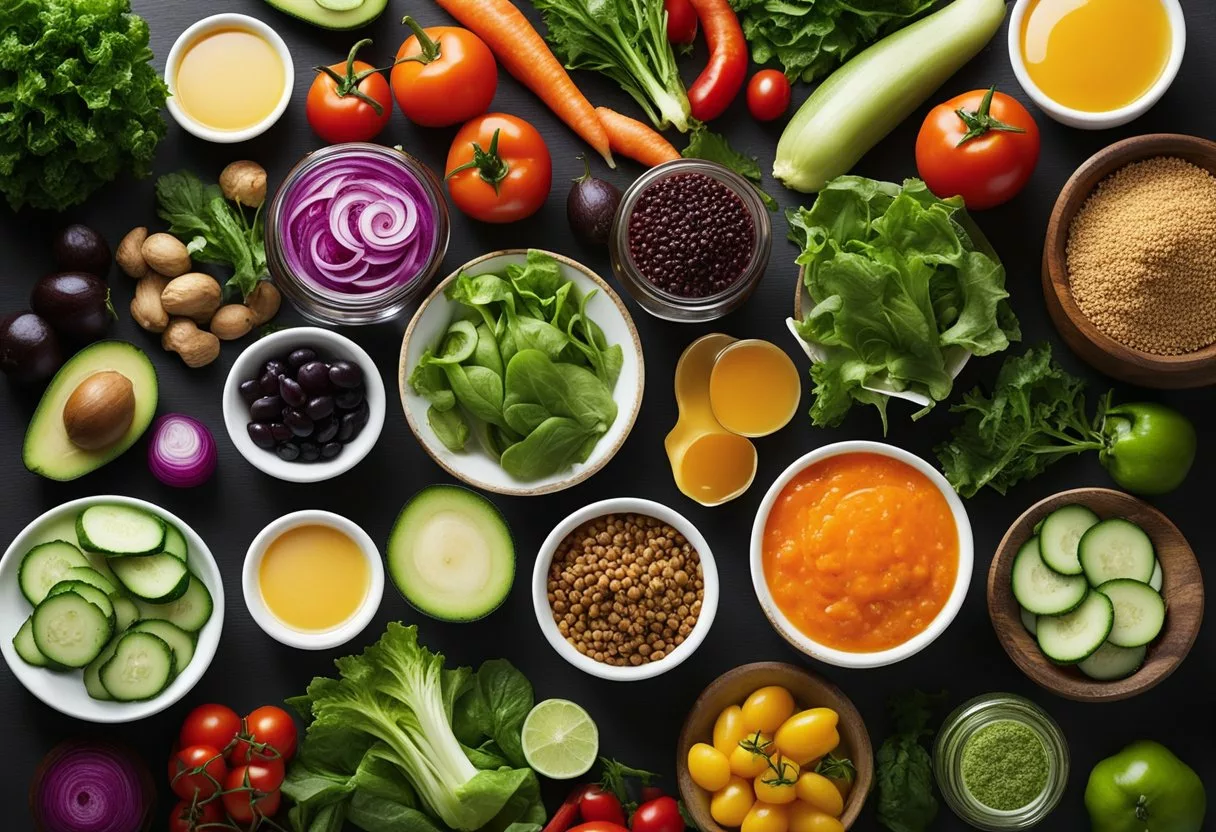
Choosing the right salad dressing is crucial for adhering to a ketogenic diet. Dressings can elevate the flavor of salads without adding excessive carbs, provided they are made with keto-friendly ingredients.
Creamy Dressing Varieties
Creamy dressings offer a rich and smooth texture that pairs well with crisp greens and crunchy vegetables. They often use a base of mayonnaise or sour cream, which are both high in fats and low in carbohydrates, making them suitable for a ketogenic lifestyle.
Ranch Dressing:
- Base: Mayonnaise, sour cream, or a combination of both.
- Seasonings: Dill, parsley, chives, garlic, and onion powder.
- Net Carbs: Typically less than 2 grams per serving.
Blue Cheese Dressing:
- Base: Sour cream with crumbled blue cheese.
- Additional Fat: Mayonnaise or full-fat yogurt to enhance creaminess.
- Acidity: A splash of vinegar or lemon juice.
- Net Carbs: Usually around 1 gram per serving.
Vinaigrette and Citrus Options
Vinaigrettes are a lighter dressing option, traditionally made with a mixture of olive oil and vinegar. For a keto-friendly version, opt for high-quality oil and a lower-carb vinegar like red wine vinegar. Citrus juices like lime or lemon can add a fresh zest without significant carbs.
Keto Vinaigrette:
- Base: Olive oil.
- Acid: Red wine vinegar or a small amount of freshly squeezed lime juice.
- Flavoring: Mustard, herbs, and spices for complexity.
- Net Carbs: Generally zero to one gram per tablespoon.
Lime Dressing:
- Base: Olive oil.
- Acid: Lime juice, fresh for a tangy kick.
- Sweetener: A keto-friendly sweetener, if desired, for balance.
- Net Carbs: Usually less than 1 gram per serving if made without added sugar.
When preparing these dressings, careful measurement of ingredients is important to keep carb counts accurate and the dressings keto-compliant.
Crunchy Additions and Toppings
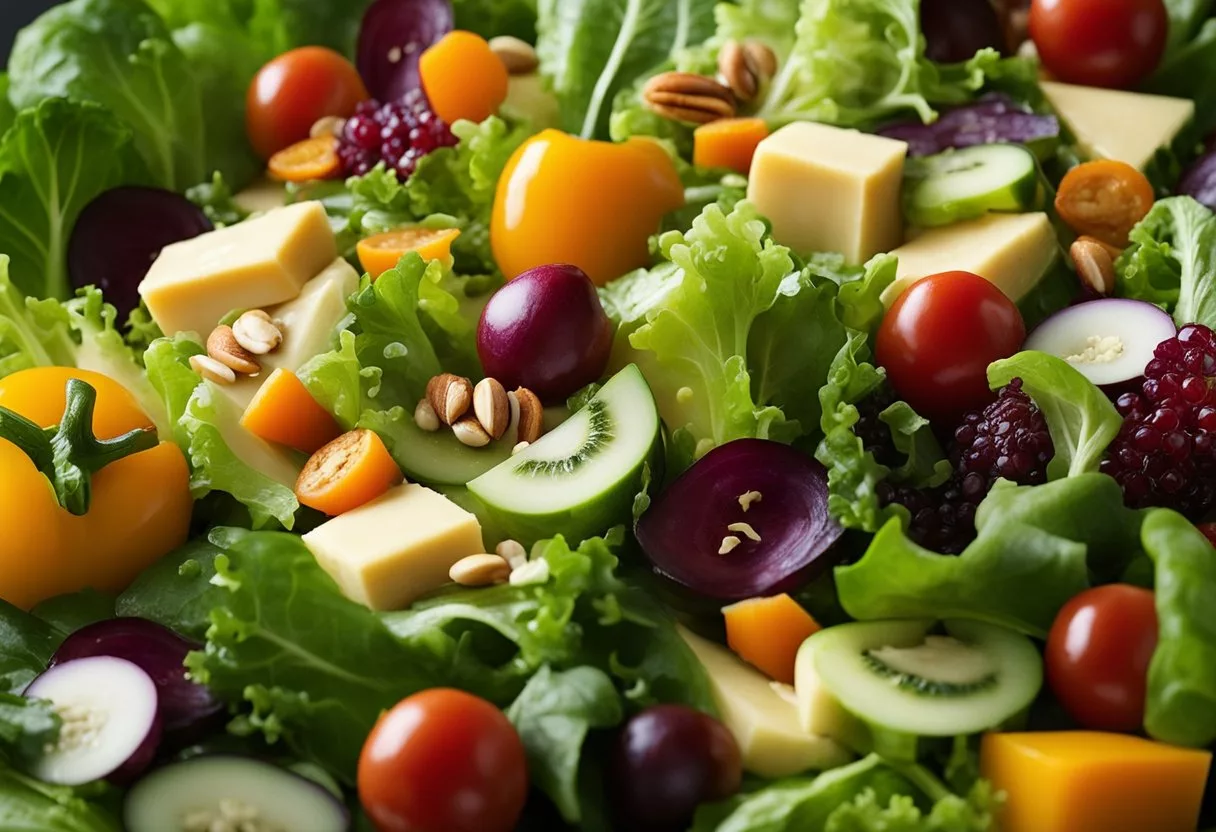
When constructing a keto salad, the crunch factor is essential for satisfying texture. The best way to add this without compromising a low-carb diet is through specific seeds, nuts, and vegetables that are keto-friendly.
Seeds and Nuts
Seeds:
- Sunflower seeds: Offer a nutty flavor and contain healthy fats.
- Pumpkin seeds (Pepitas): Provide a crunchy texture and are rich in magnesium.
Nuts:
- Pecans: Butter-like taste and very low in carbs.
- Sliced almonds: Add a delicate crunch and are high in vitamin E.
| Type | Description | Carbs per serving |
|---|---|---|
| Sunflower Seeds | Nutty flavor, healthy fats. | Approximately 2g net carbs |
| Pumpkin Seeds | Crunchy, rich in magnesium. | Around 1g net carbs |
| Pecans | Butter-like taste, low in carbs. | Roughly 1g net carbs |
| Sliced Almonds | Delicate crunch, high in vitamin E. | About 2.5g net carbs |
Low-Carb Vegetables and Add-ons
Vegetables:
- Cucumber: Adds a fresh crunch without adding too many carbs.
- Cauliflower: Can be roasted for an extra crunchy texture.
- Cherry tomatoes: Provide a burst of flavor and are keto-friendly in moderation.
- Asparagus: Can be grilled or roasted for varied texture.
- Green beans: Blanch them to maintain crispness.
Additional Crunchy Add-ons:
- Olives: They bring in a briny flavor along with a firm bite.
- Parmesan crisps: Can replace croutons for a savory crunch.
- Low-carb tortilla chips: When broken up, these chips offer a satisfying crunch.
| Vegetable | Preparation | Carbs per serving |
|---|---|---|
| Cucumber | Fresh or pickled | Approximately 2g |
| Cauliflower | Best roasted | Around 3g |
| Cherry Tomatoes | In moderation | Roughly 4g |
| Asparagus | Grilled or roasted | About 2g |
| Green Beans | Blanched, not overcooked | Less than 5g |
The choices above provide keto dieters with an array of textures and flavors to enhance any salad without compromising their dietary goals.
Keto Salad Meal Ideas
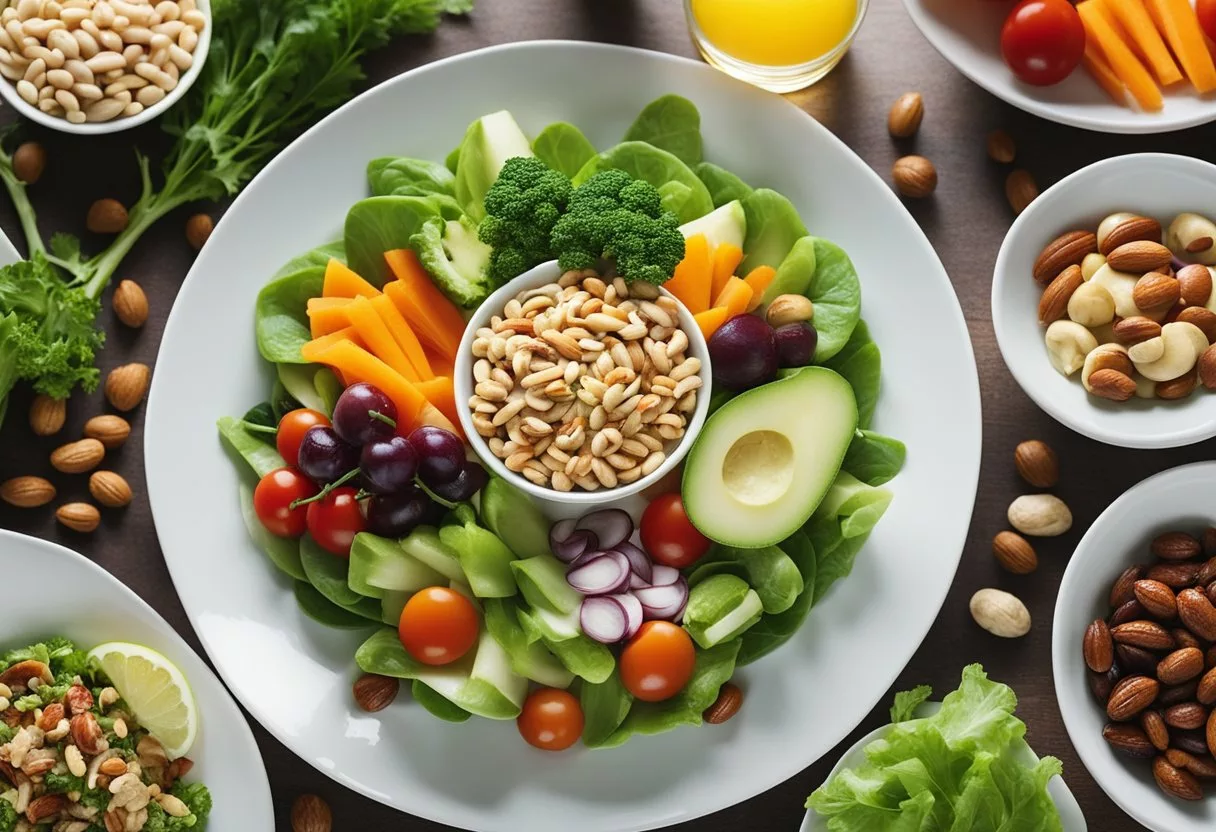
Keto salads are versatile, allowing for a variety of flavors and ingredients that align with ketogenic lifestyle choices. They can range from light and refreshing to rich and filling, making them perfect for any meal.
Light Lunch Salads
For a light lunch, a Greek Salad is an excellent choice. One can toss together crunchy cucumbers, juicy tomatoes, pitted Kalamata olives, and feta cheese, all drizzled with an olive oil-based dressing. To enhance the protein content, adding grilled chicken or shrimp is an option.
Another exemplary light lunch is the Taco Salad, where one can layer leafy greens with seasoned ground beef or turkey, full-fat cheese, and avocado. A dollop of sour cream and salsa can serve as the dressing, ensuring each bite is flavorful while keeping the carbs in check.
Hearty Dinner Combinations
For dinner, the Wedge Salad becomes a substantial option. It consists of a quarter of iceberg lettuce topped with crispy bacon, blue cheese, and a rich, creamy dressing. The simplicity yet satisfying nature makes it a beloved classic in the keto community.
On the other hand, an Antipasto Salad brings variety to the dinner table, combining various cured meats, cheese, olives, and pepperoncini in a robust Italian dressing. Including an array of textures, it’s a salad that often doubles as a complete meal.
Seasonal and Special-Occasion Salads
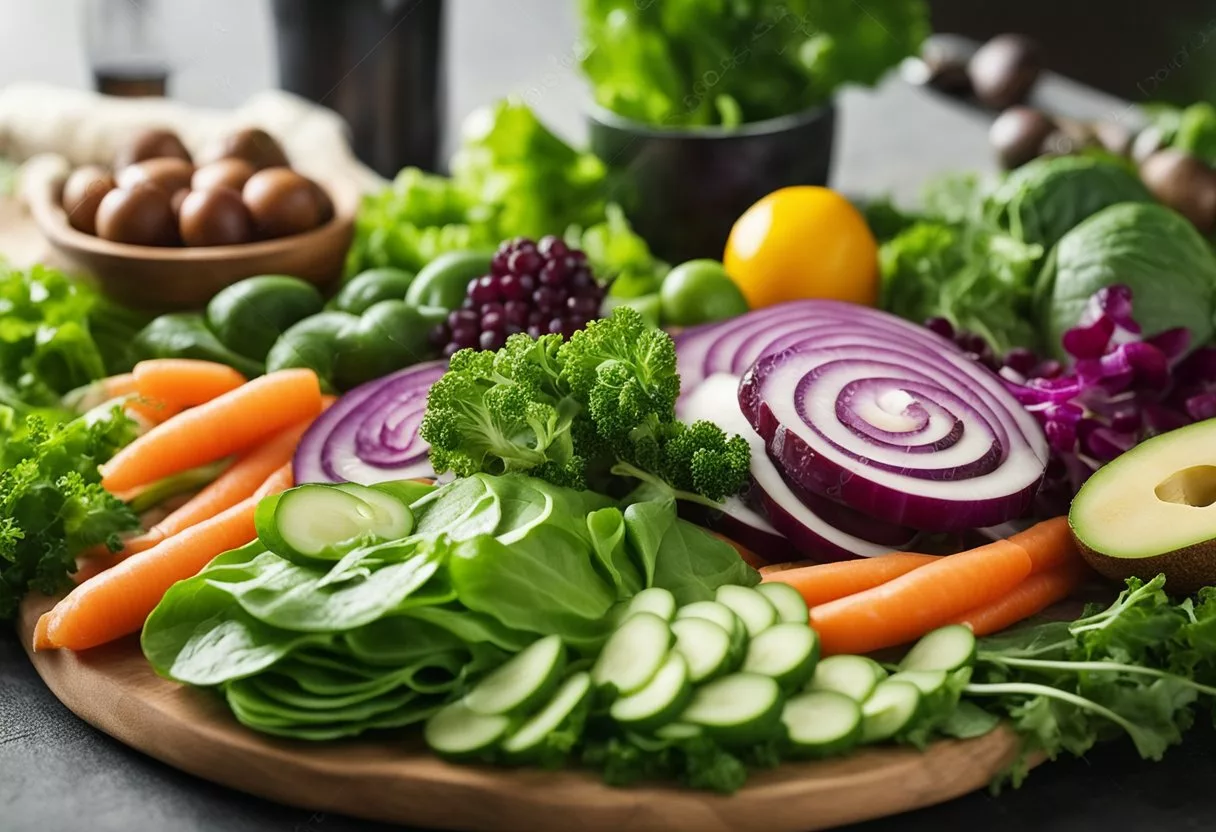
Seasonal ingredients elevate keto salads, making them fitting for both everyday eating and special occasions. Summer brings an abundance of fresh produce perfect for refreshing salads, while winter calls for hearty ingredients that can be transformed into warm, cozy dishes.
Refreshing Summer Salads
Summer salads often feature a lighter fare, ideal for hot weather and outdoor barbecues. A sweet edge can be introduced without compromising ketosis by using keto-friendly sweeteners or small portions of berries.
- BBQ Chicken Salad: Top a bed of mixed greens with grilled chicken, fresh avocado, and a drizzle of homemade keto BBQ sauce.
- Spinach Salad with Warm Bacon Dressing: Despite the warmth of the dressing, the fresh spinach keeps this salad refreshing. The warm bacon dressing not only adds a robust flavor but also pairs beautifully with summer vegetables like cherry tomatoes.
Warm and Cozy Winter Salads
Winter salads can support heart health with the inclusion of nutrient-dense, fibrous vegetables and healthy fats.
- Roasted Vegetable Salad: Hearty roasted vegetables like broccoli and cauliflower tossed with a rich, creamy dressing make for a satisfying winter dish.
- Keto Caesar Salad: A classic choice, this salad utilizes crisp Romaine lettuce, generous shavings of Parmesan cheese, and a creamy Caesar dressing to create a comforting meal that can be enjoyed even on the coldest days.
The seasonal approach ensures salads remain exciting and appropriate for any occasion, providing both variety and nutritional benefits throughout the year.
Customizing Your Keto Salad
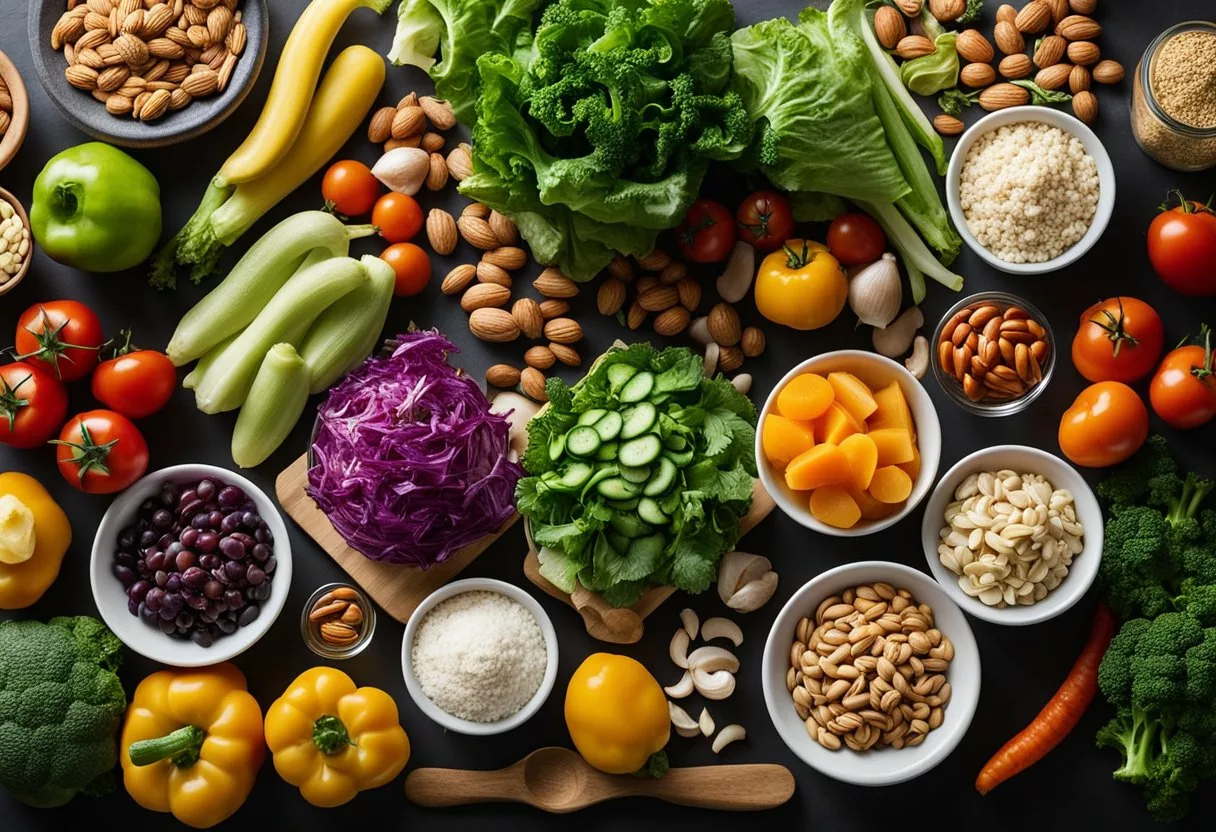
Tailoring a keto salad to personal dietary needs or taste preferences is straightforward and allows for a variety of delicious combinations. Adjusting ingredients can create dishes that are not only keto-friendly but also suit paleo and gluten-free requirements, while a little creativity can offer a myriad of flavorful variations.
Dietary Adjustments for Paleo and Gluten-Free
For those following a paleo diet, substituting dairy ingredients with alternatives like avocado or coconut cream can maintain the creaminess of dressings while keeping the salad paleo-compliant. A keto egg salad, commonly made with mayonnaise, can be made paleo by using home-made mayo from quality oils such as avocado or olive oil.
When it comes to ensuring salads are gluten-free, the focus should be on avoiding additives in store-bought dressings or seasonings that might contain gluten. Instead, one can make use of natural spices like cumin, paprika, and dill to enhance the flavors without the worry of hidden gluten.
Salad Variation Inspiration
Innovating with various salad components can lead to delicious and satisfying meals. Here’s a table with ingredients that can diversify the flavor and texture profiles of a keto salad:
| Vegetable Additions | Dressing Ideas | Spice It Up |
|---|---|---|
| Broccoli (raw or lightly steamed) | Creamy avocado dressing | Dill for a fresh, herby note |
| Sautéed mushrooms | Tangy vinaigrettes with lemon juice and olive oil | Cumin for warmth and earthiness |
| Crunchy celery for texture | Creamy dressings with herbs like chives or tarragon | Smoky paprika for depth |
Incorporating a variety of ingredients such as broccoli, mushrooms, and celery will not only diversify nutrition but also create distinct textures. They can enhance the salad making them more satisfying while aligning with keto guidelines. Dressings made from healthy fats and fresh herbs add richness and layers of flavor that elevate the humble salad to a culinary delight.
Preparing for Optimal Freshness
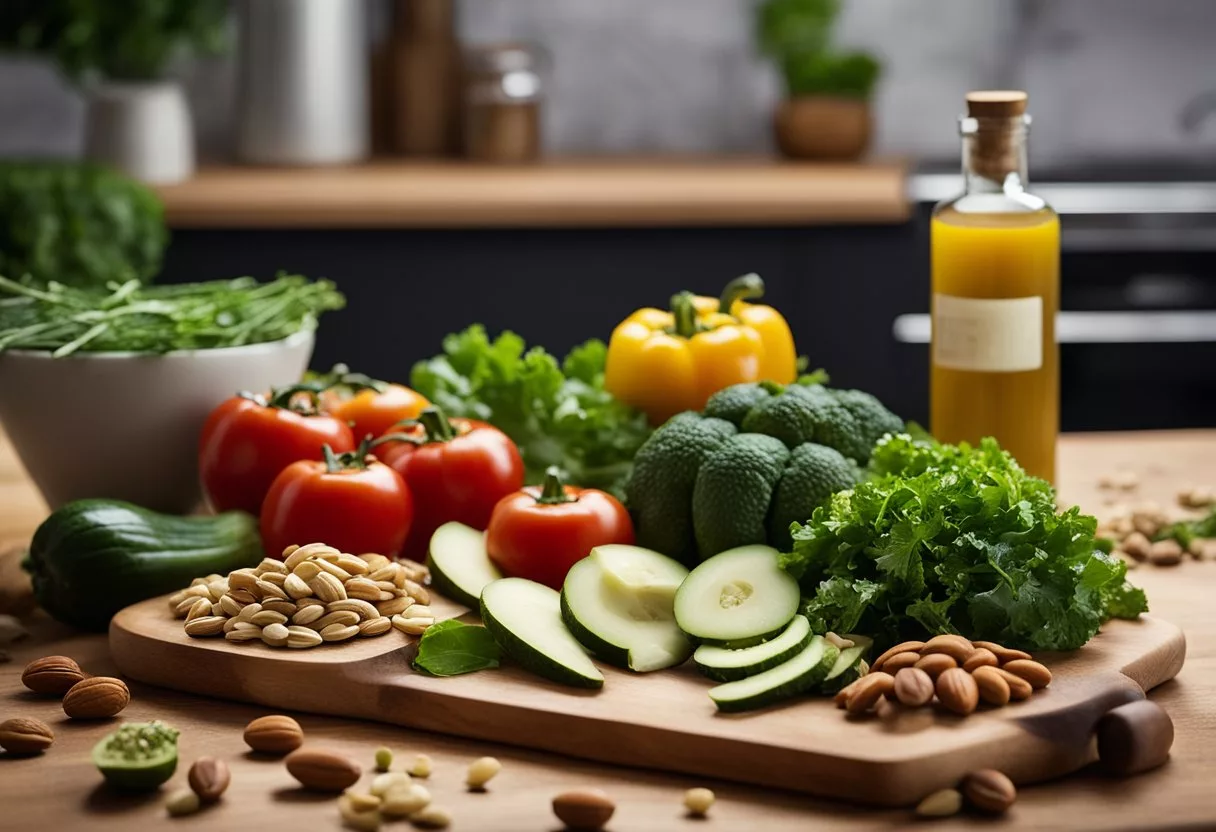
To ensure keto salads maintain their freshness and nutritional value, optimal storage and meal prep techniques are essential. They provide both convenience and quality in every bite.
Salad Storage and Packing Tips
Storing salads properly can significantly extend their freshness. Salads should be stored in the refrigerator at a temperature between 35°F and 40°F to slow down deterioration. Using airtight containers is crucial, as they prevent oxidation and moisture loss. To maintain the integrity of the ingredients, it’s best to layer salads with dressing and more delicate items, like cheese or nuts, at the top to avoid sogginess.
Key Storage Tips:
- Containers: Opt for airtight containers made of glass for chemical-free storage.
- Dressing: Store dressing separately or at the top to prevent wilting.
- Dry Greens: Ensure salad greens are dry before packing to avoid excess moisture.
Making Salads Ahead of Time
Meal prep is a game-changer for those following a ketogenic diet, making it easy to stick to dietary goals with convenience. When preparing salads ahead of time, it’s best to focus on ingredients that hold well. Heartier vegetables, proteins like grilled chicken, and hard cheeses can be prepped in advance without losing quality.
For optimal freshness and to enjoy the benefits of a convenient keto-friendly meal:
- Choose robust ingredients: Select ingredients that can withstand refrigeration for several days, such as kale, cabbage, or spinach.
- Prep components separately: Keep ingredients segregated and mix just before serving.
- Add fats for satiety: Incorporate healthy fats such as avocados or olive oil-based dressings to align with the keto diet and they also tend not to spoil quickly.
By following these steps, individuals can enjoy high-quality, nutritious keto salads with ease throughout the week.
Nutritional Information and Health Benefits
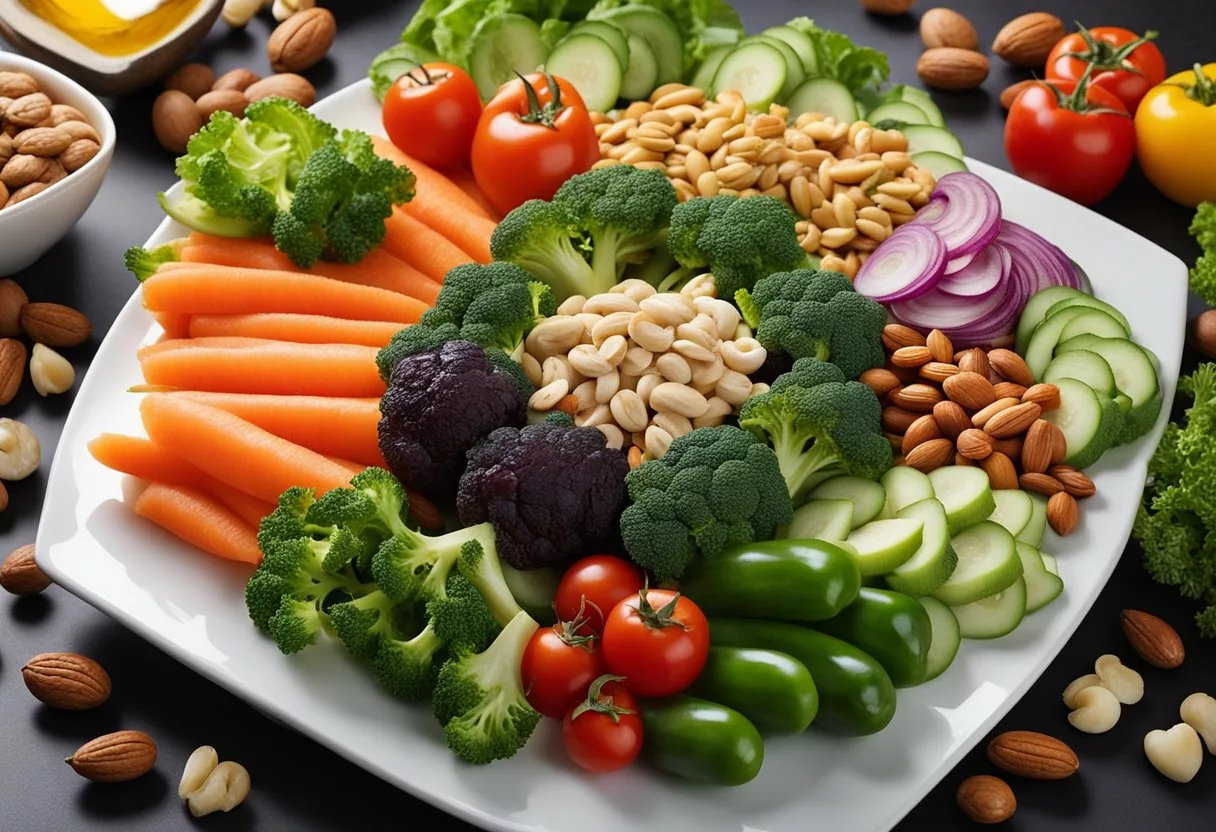
When crafting a keto-friendly salad, one should be keenly aware of the nutritional balance— focusing on healthy fats, proteins, and low-carb vegetables while avoiding items that might disrupt ketosis.
Understanding Keto Salad Macros
A keto salad typically emphasizes the inclusion of healthy fats such as avocados, olive oil, and nuts. Proteins come from sources like grilled chicken or hard-boiled eggs, contributing to muscle maintenance and satiety. It’s essential to integrate a variety of low-carb vegetables to obtain necessary fiber and vitamins. The salads should be gluten-free by nature, given the absence of high-carb, gluten-containing ingredients. Macros for keto salads should mirror the ketogenic guidelines, approximately:
- 70-80% calories from fat
- 10-20% calories from protein
- 5-10% calories from carbohydrates
Link to Heart Health and Weight Management
Salads that align with the ketogenic diet may have a positive impact on heart health by incorporating healthy fats that can support healthy cholesterol levels. Ingredients like olive oil are known for their heart-healthy properties. Furthermore, a low-carb diet that’s high in fiber and nutrition can aid in weight management due to its potential to reduce hunger and overall calorie intake. However, portion sizes and overall daily intake still need to be managed to ensure health benefits.
Salad Presentation and Serving Tips
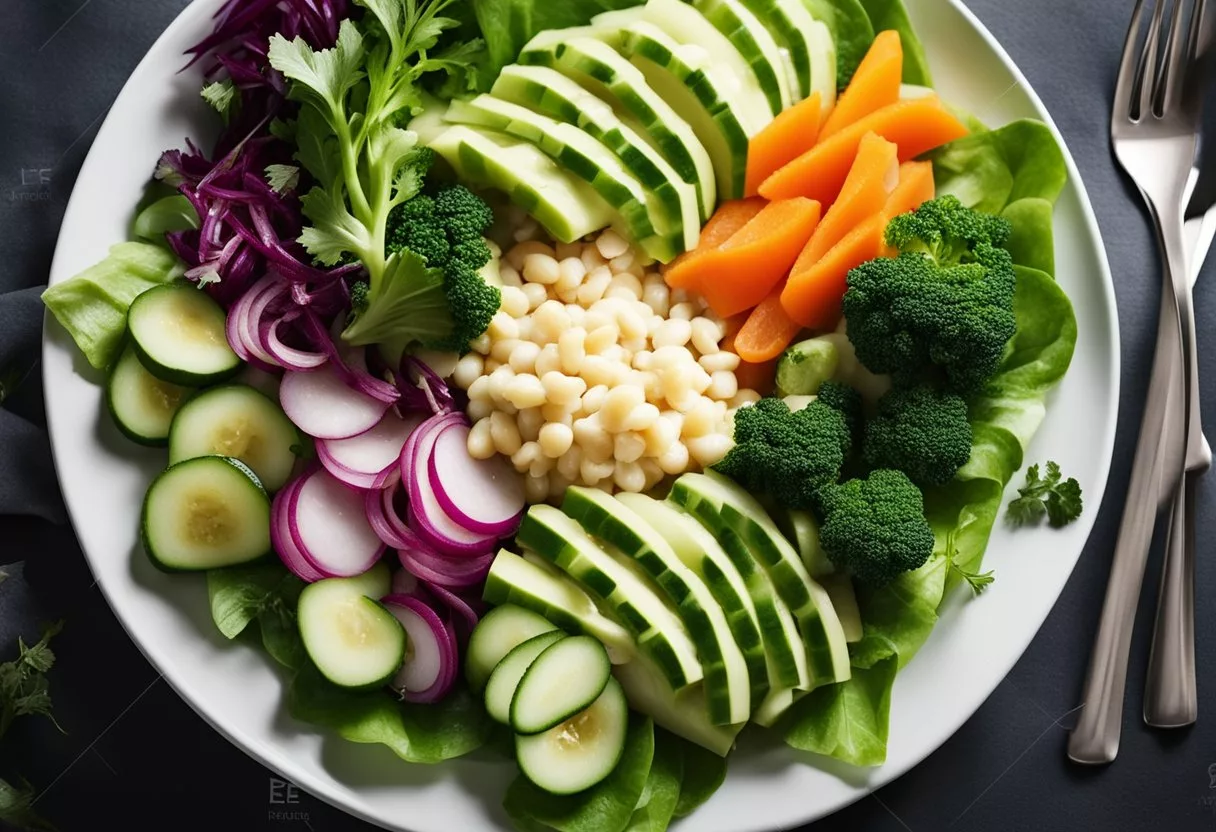
A well-presented keto salad can entice the palate before the first bite, and appropriate serving sizes ensure nutritional goals are met. This section will offer guidance on making a visually appealing keto salad and how to determine serving sizes and portions.
Making Your Keto Salad Visually Appealing
They say we eat with our eyes first. For keto salads, visual appeal is paramount in making a satisfying meal. Colors play a critical role here; one should incorporate a variety of hues using different ingredients. For example, the greens from spinach or lettuce provide a fresh base, whereas the reds of tomatoes and the purples of red cabbage add a vibrant contrast. Add a pop of color with sliced radishes or diced bell peppers. Layering these components neatly and adding a final touch with a sprinkle of fresh herbs or grated cheese can transform the dish from simple to spectacular.
Textures are equally important. A combination of crunchy ingredients like bacon bits or chopped nuts with creamy elements like slices of avocado or cheese create a delightful sensory experience. Arrange these toppings strategically, so they are evenly distributed and stand out visually.
Serving Sizes and Portions
Determining the right serving size for a keto salad is crucial to maintain its low-carb integrity. One can start with a base of leafy greens; a good rule of thumb is about 2 cups of loosely packed leaves per serving. Then, the addition of protein should be measured – for instance, a serving of 3-4 ounces of grilled chicken or a similar quantity of other lean proteins like shrimp or tuna is sufficient.
For a precise breakdown, here’s an example serving guide for a single portion:
| Ingredient | Serving Size |
|---|---|
| Leafy Greens | 2 cups (loose) |
| Protein (chicken, shrimp, etc.) | 3-4 ounces |
| Avocado | ¼ medium avocado |
| Cheese | 1 ounce |
| Salad Dressing | 1-2 tablespoons |
One should also be mindful of the carb content in dressings and toppings, carefully measuring to avoid overindulging. A balanced keto salad should prioritize protein and fat over carbohydrates, to align with the keto diet’s macronutrient ratios.
Frequently Asked Questions
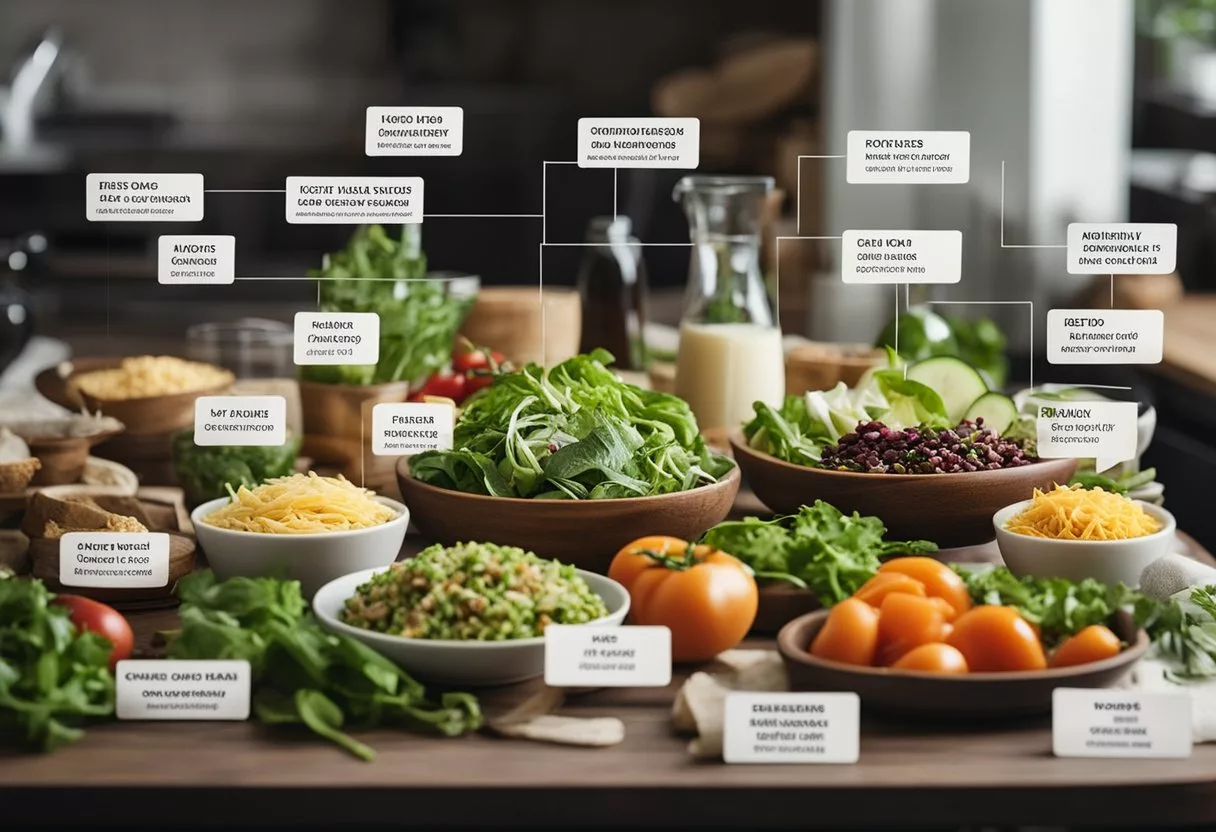
Within the ketogenic diet, the right ingredients can make all the difference. This section addresses common queries to ensure your salads are delicious, nutritious, and keto-approved.
What types of dressings are suitable for a keto diet when preparing salads?
For those on a keto diet, dressings high in healthy fats and low in carbs are essential. Options include classic ranch, creamy Caesar, olive oil with lemon zest or vinegar, and mayonnaise-based dressings. It’s advised to avoid dressings with added sugar or high-carb ingredients.
Which vegetables should I include in a keto-friendly green salad?
Keto-friendly green salads should focus on low-carb vegetables. These include leafy greens like spinach and kale, along with additions like broccoli, cauliflower, and bell peppers. Vegetables like tomatoes and avocados are also great, although tomatoes should be used in moderation due to their higher carb content.
Can you suggest some keto salad ideas that are perfect for a barbecue?
Salads that go well with barbecues tend to have a hearty base. One might opt for a salad with grilled chicken or steak strips, coupled with mixed greens and a rich, creamy dressing. Another option is a charred vegetable salad with zucchini, bell peppers, and feta cheese.
What are some refreshing cold salad options that align with ketogenic guidelines?
Cold keto salads can include ingredients like tuna or chicken mixed with celery, mayonnaise, and herbs. Egg salad with avocado and a squirt of lemon juice offers a cool, satiating option. A cucumber and dill salad with sour cream dressing is another refreshing choice.
How can I incorporate cucumbers into a keto meal plan through salads?
Cucumbers are an excellent addition to keto salads due to their high water content and low carb count. They can be spiralized into noodle-like shapes for a refreshing base, mixed with creamy goat cheese and mint, or chopped and combined with a vinegar-based dressing for a crunchy side dish.
What ingredients are typically found in a keto-compliant Cobb salad?
A keto Cobb salad usually consists of a mix of greens, hard-boiled eggs, avocado, cheese like blue or feta, crispy bacon, and grilled chicken. The dressing is typically a keto-friendly ranch or blue cheese. It’s a high-fat, moderate protein, and low-carb salad suitable for a keto diet.